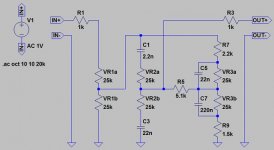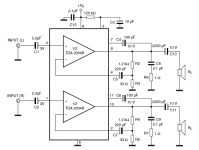Hi, I've just built an amplifier with TDA2004 chip. It was my first attempt so I was a little bit experimenting with that. So I bought a switch mode power supply which was actually for LED strips. Then I constructed whole amplifier with XH-M802 preamp on perfboard with no copper, so leads are used more than enough. There is a terrible hiss in the speakers, not much depending on volume and tone control. So I think it's because of power supply or I heard somewhere that using leads in audio is not good idea.
Does anybody know why is it happening so? Should I add some extra capacitors to power supply, build a filter to power supply or to the output stage? Or shielding the circuit will be enough?
Schematic diagrams are down below.
Thanks so much for help!
Does anybody know why is it happening so? Should I add some extra capacitors to power supply, build a filter to power supply or to the output stage? Or shielding the circuit will be enough?
Schematic diagrams are down below.
Thanks so much for help!
Attachments
Probably it's the noisy power supply, try running it with a linear lab supply to see.
Otherwise it could be oscillation.
Otherwise it could be oscillation.
Specifically which switch mode LED supply are you using?
Did you follow the recommended PC layout shown in the TDA2004 data sheet? Here: https://www.st.com/resource/en/datasheet/tda2004r.pdf
If the layout isn't right it can lead to oscillation, i.e. noise.
Mike
Did you follow the recommended PC layout shown in the TDA2004 data sheet? Here: https://www.st.com/resource/en/datasheet/tda2004r.pdf
If the layout isn't right it can lead to oscillation, i.e. noise.
Mike
Scheme is the same. But board layout is different. I haven't heard before that layout of components could lead to hiss like this. I don't know how to explain it, but I hear it even if the music is playing at normal volume.
Hi,
Some of (most) these led power supplies are really basic, with little or no filtering. After all, they are really just meant to light led strips and so noise and filtering are not a major concern. As suggested, try a laboratory power supply and see if there is any difference.
john
Some of (most) these led power supplies are really basic, with little or no filtering. After all, they are really just meant to light led strips and so noise and filtering are not a major concern. As suggested, try a laboratory power supply and see if there is any difference.
john
Some LED SMPSes are current sources rather than voltage sources. You'll definitely want a voltage source for your amp.
The TDA2004 will work down to 8 V, so you may be able to run it from a 9 V battery. The absolute maximum supply voltage is 18 V (says the data sheet).
Tom
The TDA2004 will work down to 8 V, so you may be able to run it from a 9 V battery. The absolute maximum supply voltage is 18 V (says the data sheet).
Tom
No respectable amplifier for high fidelity would be powered by an SMPS.
I dunno who dreamt up that idea, probably some idiot 14 year old kid.
I dunno who dreamt up that idea, probably some idiot 14 year old kid.
Scheme is the same. But board layout is different. I haven't heard before that layout of components could lead to hiss like this. I don't know how to explain it, but I hear it even if the music is playing at normal volume.
Again: Specifically which switch mode LED supply are you using?
Mike
Sorry, but I couldn't find any product list about that smps in English. But I tried a PC power supply (I haven't got any other with 12V output) and it works just fine. Thanks very much for help and advices guys!
But especially not to wiseoldtech. Try to be helpful on forums, don't abuse others for their mistakes ��
But especially not to wiseoldtech. Try to be helpful on forums, don't abuse others for their mistakes ��
No respectable amplifier for high fidelity would be powered by an SMPS.
I dunno who dreamt up that idea, probably some idiot 14 year old kid.
Show what you know, it obviously is not worth mentioning.
His Occupation
Semi Retired - still called upon for quality servicing due to lack of knowledgeable technicians.
You are very opinionated, rather be helpful if you can manage it.
Last edited:
No respectable amplifier for high fidelity would be powered by an SMPS.
I dunno who dreamt up that idea, probably some idiot 14 year old kid.
Why not?
Show what you know, it obviously is not worth mentioning.
His Occupation
Semi Retired - still called upon for quality servicing due to lack of knowledgeable technicians.
You are very opinionated, rather be helpful if you can manage it.
I thought I was being helpful.
To warn others that SMPS supplies for audio are crap - cutbacks in quality.
I ought to know, after 45 years in the service shop.
There is a typo in the datasheet schematic. If you read the table on section 3, the recommended value for R3 is 3.3 ohms, not 33 ohm as printed in the "test and application circuit". The gain of this schematic seems to be pretty high and the input impedence is 200K, this is a recipe for hiss. Try to add a 47K resistor from input to ground (before the decoupling capacitor). Do you have a 12V battery to check the amplifier circuit alone, without the LED power supply?
I thought I was being helpful.
To warn others that SMPS supplies for audio are crap - cutbacks in quality.
I ought to know, after 45 years in the service shop.
Some certainly are: mostly the older designs that have now trickled down to cheap consumer products. New designs are better, with proper care they may be used for audio.
Some certainly are: mostly the older designs that have now trickled down to cheap consumer products. New designs are better, with proper care they may be used for audio.
Ok, but how much "newer", please tell me.
Because I'm in the process of replacing a plate amp in a subwoofer for a friend.
Used infrequently for maybe 3 years.. which of course the warranty runs out and issues show up.
Big name brand, with a lousy crap SMPS pathetic design.
I'm replacing it with an "old school" design, a "real" amp, using a nice beefy power transformer for reliability.
I've been in the service business long enough to watch the "changes' as time goes by, and they're not very impressive.
No respectable amplifier for high fidelity would be powered by an SMPS.
I dunno who dreamt up that idea, probably some idiot 14 year old kid.
Is the TDA2004 high fidelity? I thought it was class B, specifically designed for car stereos?
A real 12 volt SMPS, designed to deliver a couple of amps, with a proper filtered output would be fine for a TDA200x amplifier. You just need enough headroom on current capacity to handle peak current - which might be 2 amps. Something designed for lighting ballast applications is way too dirty, even for a car radio amplifier. You can’t see 10 volts of power supply ripple, but you sure can hear it. Those amps are not the end al be all of fidelity, but they are listenable as long as the power supply doesn’t completely misbehave, which is what was happening. A laptop supply or something like it is as good as anything else. You can find them surplus for a couple of bucks. A 12 volt wall wart with an old school transformer in it would be fine. Building something out of a 600 VA toroid, a 12 Henry choke and 68,000 uf of capacitors won’t make the amp “better” enough to be worthwhile.
Better that it was a terrible hiss rather than an evil hiss...
Then a band of demons joined in and it sounded something like this.....
- Status
- Not open for further replies.
- Home
- Amplifiers
- Chip Amps
- Terrible hiss

